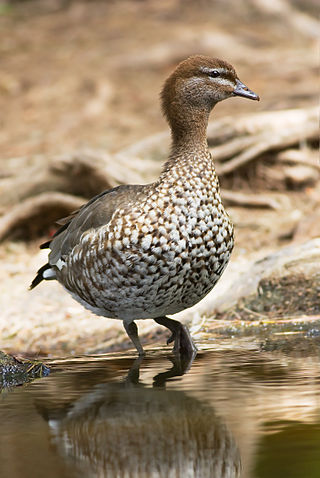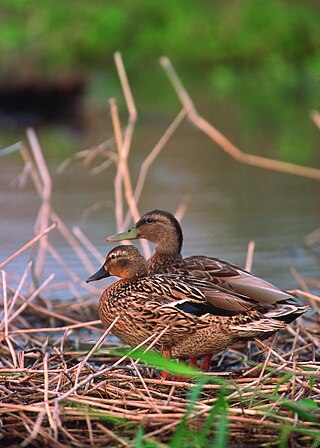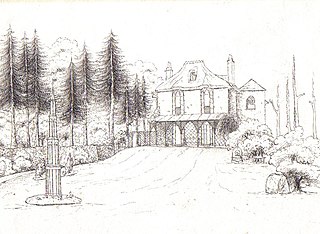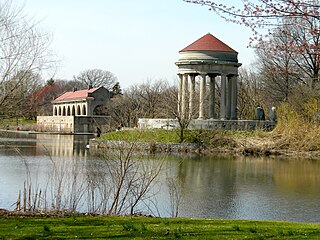
Duck is the common name for numerous species of waterfowl in the family Anatidae. Ducks are generally smaller and shorter-necked than swans and geese, which are members of the same family. Divided among several subfamilies, they are a form taxon; they do not represent a monophyletic group, since swans and geese are not considered ducks. Ducks are mostly aquatic birds, and may be found in both fresh water and sea water.

The mallard or wild duck is a dabbling duck that breeds throughout the temperate and subtropical Americas, Eurasia, and North Africa. It has been introduced to New Zealand, Australia, Peru, Brazil, Uruguay, Argentina, Chile, Colombia, the Falkland Islands, and South Africa. Belonging to the subfamily Anatinae of the waterfowl family Anatidae, mallards live in wetlands, eat water plants and small animals, and are social animals preferring to congregate in groups or flocks of varying sizes.

The blue-winged teal is a species of bird in the duck, goose, and swan family Anatidae. One of the smaller members of the dabbling duck group, it occurs in North America, where it breeds from southern Alaska to Nova Scotia, and south to northern Texas. It winters along the Pacific and Atlantic coasts and south into the Caribbean islands and Central America.

A decoy is usually a person, device, or event which resembles what an individual or a group might be looking for, but it is only meant to lure them. Decoys have been used for centuries most notably in game hunting, but also in wartime and in the committing or resolving of crimes.

Sir Peter John Viggers was a British Conservative politician and lawyer who served as Member of Parliament (MP) for Gosport for 36 years, from 1974 to 2010. He stepped down as a result of the investigation of MPs' expenses.

Water garden or aquatic garden, is a term sometimes used for gardens, or parts of gardens, where any type of water feature is a principal or dominant element. The primary focus is on plants, but they will sometimes also house waterfowl, or ornamental fish, in which case it may be called a fish pond. They vary enormously in size and style.

The Australian wood duck, maned duck or maned goose is a dabbling duck found throughout much of Australia. It is the only living species in the genus Chenonetta. Traditionally placed in the subfamily Anatinae, it might belong to the subfamily Tadorninae (shelducks); the ringed teal may be its closest living relative.

The spotted whistling duck is a member of the duck family Anatidae. It is also referred to as the "spotted tree duck". This duck can be found in Indonesia, New Guinea, Australia and the Philippines. Spotted ducks are also held in captive populations.

The Hawaiian duck or koloa is a species of bird in the family Anatidae that is endemic to the large islands of Hawaiʻi. Taxonomically, the koloa is closely allied with the mallard. It differs in that it is monochromatic and non-migratory. As with many duck species in the genus Anas, Hawaiian duck and mallards can interbreed and produce viable offspring, and the koloa has previously been considered an island subspecies of the mallard. However, all major authorities now consider this form to be a distinct species within the mallard complex. Recent analyses indicate that this is a distinct species that arose through ancient hybridization between mallard and the Laysan duck. The native Hawaiian name for this duck is koloa maoli, or simply koloa. This species is listed as endangered by the IUCN Red List of Threatened Species, and its population trend is decreasing.

The Arapaho National Wildlife Refuge is a United States National Wildlife Refuge located in north-central Colorado. It is one of over 560 national wildlife refuges which manages and protects natural resources for future generations. The refuge is located in North Park in central Jackson County south of the town of Walden. The refuge was established in 1967 to furnish waterfowl with a suitable place to nest and rear their young. It was created in part to offset losses of nesting habitat in the prairie wetland region of the Midwest. It is located in the valley of the Illinois River, a tributary of the North Platte River. It is administered by the United States Fish and Wildlife Service.

Waterfowl hunting is the practice of hunting aquatic birds such as ducks, geese and other waterfowls or shorebirds for sport and meat. Waterfowl are hunted in crop fields where they feed, or in areas with bodies of water such as rivers, lakes, ponds, wetlands, sloughs, or coasts. There are around 3 million waterfowl hunters in the United States alone.
The Yazoo National Wildlife Refuge is a 12,941 acre (52.4 km2) National Wildlife Refuge located in Washington County, Mississippi. Named after the Yazoo tribe, it was established to provide waterfowl and other migratory birds in the Mississippi Flyway with nesting, feeding, brooding, and resting habitat.

Woodway House is in Teignmouth, South Devon, England. It was at one time a farm on lands held by the Bishops of Exeter. In around 1815 a thatched "cottage" in the "cottage ornée" style of Horace Walpole's (1717–1797) Thames-side villa, Strawberry Hill, was built here by Captain James Spratt of the Royal Navy.

Franklin Delano Roosevelt (FDR) Park is a park located along the Delaware River in the southernmost point of South Philadelphia, Pennsylvania, comprising some 348 acres (1.41 km2), about 125 acres (0.51 km2) of buildings, roadways, pathways for walking, landscaped architecture, and a variety of picnic and recreation areas placed within about 77 acres (310,000 m2) of natural lands including ponds and lagoons.

A water bird, alternatively waterbird or aquatic bird, is a bird that lives on or around water. In some definitions, the term water bird is especially applied to birds in freshwater ecosystems, although others make no distinction from seabirds that inhabit marine environments. Some water birds are more terrestrial while others are more aquatic, and their adaptations will vary depending on their environment. These adaptations include webbed feet, beaks, and legs adapted to feed in the water, and the ability to dive from the surface or the air to catch prey in water.

A duck decoy is a device to capture wild ducks or other species of waterfowl. Decoys had an advantage over hunting ducks with shotguns as the duck meat did not contain lead shot. Consequently, a higher price could be charged for it.
A duck decoy is a man-made object resembling a duck. Duck decoys are typically used in waterfowl hunting to attract real ducks, but they are also used as collectible art pieces. Duck decoys were historically carved from wood, often Atlantic white cedar wood on the east coast of the United States, or cork. Modern ones may also be made of canvas and plastic. They are often painted to resemble various kinds of waterfowl.

Pilling's Pond is a privately owned urban waterfowl reserve and breeding ground in the North Seattle neighborhood of Licton Springs, Seattle, Washington. It was created by lifetime resident Charles A. Pilling and has been a bird breeding site and a roadside attraction since the 1920s.

The Gosport Conservative Party parliamentary primary of 2009 was the 1st open primary election used to select the Conservative Prospective Parliamentary Candidate for the constituency of Gosport. The election was held on Friday 4 December 2009 under the first-past-the-post system. The incumbent MP, Sir Peter Viggers, had announced his intention to decline re-election following the parliamentary expenses scandal, in which he gained huge media attention for attempting to claim £1,645 for a duck house.

The Duck House is a 2013 comedy farce play written by Dan Patterson and Colin Swash. It is based around the events of the 2009 UK parliamentary expenses scandal, and made its world premiere at the Yvonne Arnaud Theatre in October 2013, at the start of a five-week UK tour. The production then transferred to the West End's Vaudeville Theatre, where it ran until 29 March 2014.





























